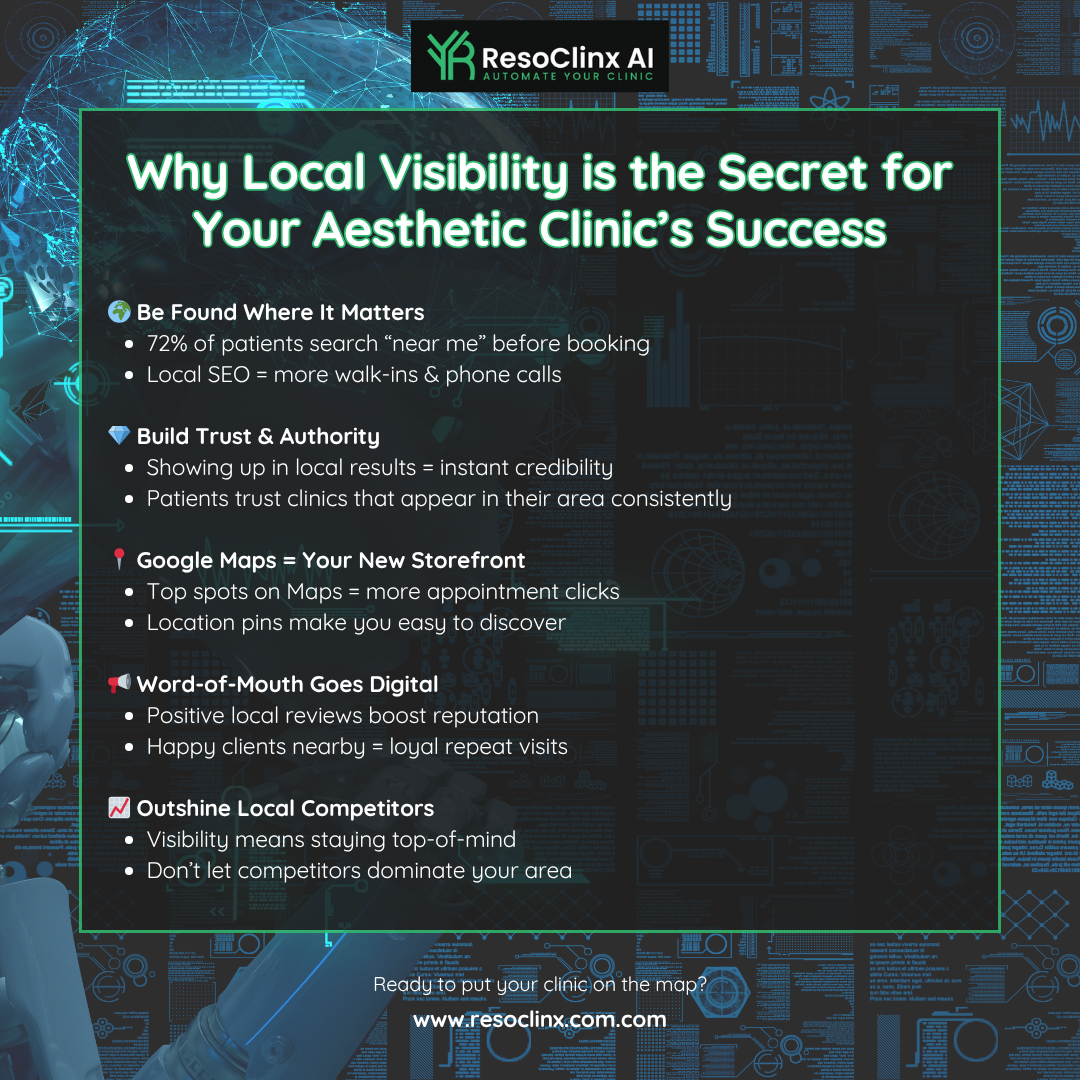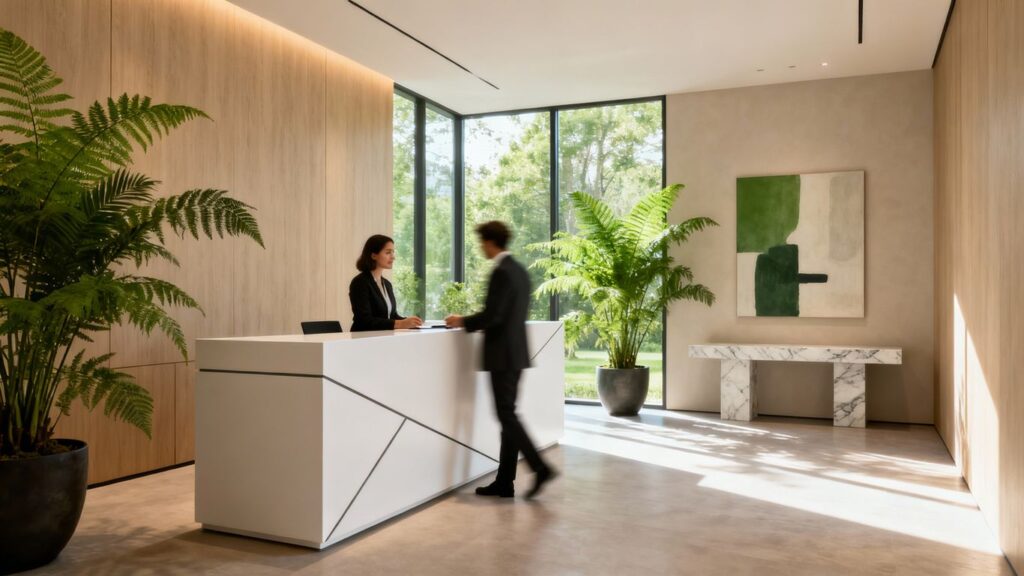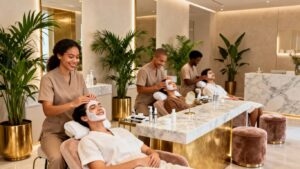Imagine this: someone nearby types “best aesthetic clinic near me” into Google. Within seconds, a list appears on Google Maps. Whether your clinic is at the top—or hidden below—could mean the difference between gaining a new client or losing them to a competitor.
Ranking higher on Google Maps isn’t luck—it’s strategy. The best part? Many of the ranking factors are completely in your control. In this post, you’ll discover the local SEO steps that put your aesthetic clinic on the map—literally.
Key Takeaways
- Keep your Google Business Profile complete and updated with photos, posts, and services.
- Collect positive reviews and ensure NAP consistency (Name, Address, Phone).
- Build trust with an informative website that highlights results and answers patient questions.
- Optimise your site with local keywords (service + location) to attract nearby clients.
- Ensure a fast, mobile-friendly, and secure website for both patients and Google.
Optimising Your Google Business Profile For Local Visibility

Your Google Business Profile (GBP) is arguably the most important tool you have for local search visibility. It’s often the very first impression a potential client has of your clinic when they search on Google or look at Google Maps.
Getting this profile right can make a significant difference in attracting new patients.
Claiming and Verifying Your Clinic’s Listing
The absolute first step is to claim and verify your clinic’s listing. This gives you full control over the information that appears to the public. If you haven’t done this already, you can follow Google’s straightforward guide to get started.
It’s a simple process that unlocks the ability to manage your presence effectively.
Ensuring NAP Consistency Across Platforms
Next, you need to make sure your NAP details – your Name, Address, and Phone number – are exactly the same everywhere online. This means your GBP, your website, and any other online directories your clinic is listed in.
Inconsistencies can confuse search engines and negatively impact your ranking. Think of it like this: if Google sees different addresses for your clinic, how can it be sure which one is correct? Keeping this information identical is vital for building trust with search engines.
Completing All Profile Sections With Detail
Don’t leave any stone unturned when filling out your profile. Make sure your business hours are accurate, especially if they change seasonally or for holidays. List all the services you offer, using clear and specific language that potential clients would use when searching.
A fully completed profile makes your clinic significantly more likely to be chosen by a potential patient. It’s also a good idea to add a compelling business description that highlights what makes your clinic special.
Utilising High-Quality Visuals and Google Posts
Since aesthetics is a visual field, high-quality photos are a must. Upload professional images of your clinic’s exterior and interior, your treatment rooms, and your team. Before-and-after photos (with patient consent, of course) are incredibly powerful for demonstrating results.
Beyond photos, use Google Posts to share timely updates like offers, new treatments, or clinic news. While posts don’t directly improve rankings, they keep your profile fresh and encourage more clicks.
Use them to announce special offers, new treatments, or clinic news. Regularly posting keeps your profile fresh and shows Google that your business is active and engaged. It’s a great way to capture attention and provide timely information to your audience.
Building Local Trust Through Reviews and Citations

When people are looking for an aesthetic clinic, they’re not just searching for services; they’re searching for a place they can trust. Online reviews and consistent directory listings play a massive role in building that trust.
Think of it as your clinic’s digital handshake – it needs to be firm and reliable.
Encouraging Satisfied Clients to Leave Feedback
Happy clients are your best advocates. When someone has had a great experience, they’re often willing to share it, but they might need a gentle nudge. Make it easy for them to leave a review.
A simple, polite request at the end of their appointment, perhaps via a follow-up email or a discreet card, can make all the difference. You could even include a QR code that links directly to your Google review page.
The more positive reviews you have, the more credible your clinic will appear to potential new patients.
Responding Professionally to All Reviews
It’s not just about collecting positive feedback; how you handle all reviews matters. For positive ones, a simple thank you goes a long way. For negative reviews, it’s an opportunity to show you care and are committed to improving.
Respond promptly and professionally. Acknowledge their concern, apologise if appropriate, and offer to discuss the matter further offline. This shows potential clients that you value feedback and are proactive in addressing issues.
Enhancing Website Authority and Trust

Building a strong online presence for your aesthetic clinic is about more than visibility—it’s about trust. Potential clients aren’t only searching for the closest clinic; they’re looking for one that inspires confidence. Your website is the foundation for that trust, positioning your clinic as a leader in aesthetic medicine.
Demonstrating Medical Expertise Through Content
Your website should be a resource that clearly communicates your clinic’s knowledge and skill. Think of your blog and service pages as opportunities to educate your audience. By consistently publishing informative articles that answer common patient questions, you position your clinic as a helpful authority.
This could include detailed guides on specific procedures, explanations of different skin types and concerns, or even discussions about the science behind your treatments. The more valuable and relevant information you provide, the more likely visitors are to see your clinic as a trusted expert.
Showcasing Real Patient Results and Testimonials
Nothing builds trust quite like seeing tangible proof of your work. High-quality before-and-after photos are incredibly persuasive, allowing potential clients to visualise the results they could achieve. Ensure these images are clear, well-lit, and taken from consistent angles.
Alongside visuals, genuine patient testimonials offer social proof. Encourage satisfied clients to share their experiences, and feature these reviews prominently on your website. This direct feedback from real people can be far more impactful than any marketing claim.
Establishing Your Clinic as a Knowledge Hub
To truly stand out, aim to make your website a go-to source for information on aesthetic treatments and skin health. This involves not only creating detailed service pages that explain each treatment thoroughly but also developing a blog that covers a wide range of relevant topics.
Consider creating content that addresses patient concerns about recovery, expected outcomes, and the technology used.
By consistently providing accurate, helpful, and engaging content, you build a reputation as a knowledgeable and reliable clinic, which search engines and patients alike will recognise.
Leveraging On-Page SEO for Local Search Dominance
To really get found by people in your local area, you need to make sure your website is speaking the same language as Google and your potential clients. This is where on-page SEO comes in.
It’s all about optimising the content and structure of your website so that search engines understand what you do and where you do it. Think of it as making your clinic’s digital shopfront as clear and inviting as possible.
Conducting Local Keyword Research for High-Intent Searches
Understanding what terms people actually type into Google when they’re looking for aesthetic treatments is the first step. It’s not just about broad terms like ‘Botox’; it’s about specifics. People often search using a combination of the service they want and their location, such as ‘Botox in Manchester’ or ‘laser hair removal near Leeds’.
These are known as high-intent keywords because they show someone is ready to book. By finding out which of these terms are most popular for your services and your area, you can tailor your website content to match.
Incorporating Location-Specific Service Keywords
Once you know what people are searching for, you need to weave those keywords naturally into your website.
This means mentioning your services alongside your location in a way that makes sense. For example, instead of just having a page about ‘dermal fillers’, you’d have a page titled ‘Dermal Fillers in Birmingham’ or ‘Affordable Dermal Fillers in the Jewellery Quarter’.
This helps Google understand that your clinic is a relevant result for someone searching in that specific area. It’s about being clear and direct with both search engines and potential patients.
Optimising Title Tags and Meta Descriptions
Your title tags and meta descriptions are like the headlines and short summaries that appear in Google search results. They’re your first chance to grab someone’s attention.
A good title tag for a clinic might be something like: ‘Expert Botox Treatments in Liverpool | [Your Clinic Name]’. The meta description should then expand on this, giving a brief, compelling reason to click, perhaps mentioning specific benefits or unique selling points.
These small snippets have a big impact on whether someone clicks through to your site.
It’s important that these elements are:
- Relevant: Accurately describe the page content.
- Compelling: Encourage users to click.
- Keyword-Rich: Include your primary local keywords.
- Unique: Each page should have its own distinct title and description.
Making sure your title tags and meta descriptions are well-crafted is a simple yet powerful way to improve your local search visibility and attract more relevant visitors to your website.
Prioritising Technical SEO for a Seamless User Experience

When people search for aesthetic clinics, they’re not just looking for information; they’re looking for a place they can trust and easily interact with. This is where technical SEO comes in.
It’s all about making sure your website works perfectly behind the scenes, so visitors have a smooth experience from the moment they land on your page. Think of it as the foundation of your online presence – if it’s shaky, nothing else will stand up properly.
Ensuring Mobile-First Design and Responsiveness
Most searches for local services happen on mobile phones these days. Google actually uses the mobile version of your website to decide how it ranks. So, if your site looks clunky or is hard to use on a phone, you’re going to struggle.
We need to make sure your website looks good and works well on any device, whether it’s a smartphone, tablet, or desktop computer. This means text should be readable without zooming, buttons should be easy to tap, and the whole layout should adapt smoothly.
Optimising Page Speed for Faster Loading
Nobody likes waiting for a website to load. If your pages take too long, people will just leave and go to a competitor. Slow loading times can be caused by large images, unoptimised code, or poor hosting.
We’ll look at ways to speed things up, like compressing images and cleaning up the website’s code. A faster site means happier visitors and better rankings.
Implementing Website Security (HTTPS)
Having a secure website, shown by HTTPS in the address bar, is really important. It tells visitors that their connection is private and that their data is protected. This is especially vital for clinics handling personal information.
Google also sees HTTPS as a positive signal, which can help your search rankings. It’s a straightforward way to build trust with potential patients.
Utilising Schema Markup for Contextual Understanding
Schema markup is like a special language that helps search engines understand what your website is about. By adding this code, you can give search engines more context about your clinic, like your services, opening hours, and even patient reviews.
This can lead to more detailed and eye-catching listings in search results, often called ‘rich snippets’. For example, it might show your star rating directly in the search results, making your listing stand out and encouraging more clicks.
Measuring Success and Partnering for Continuous Growth
Measuring and analysing your results needs to be a core part of your strategy. The beauty of digital marketing is that it’s measurable. Unlike traditional advertising, where it’s hard to tell if that flyer actually brought in customers, local SEO gives you clear insights into what’s working and what needs a tweak. We focus on tracking the metrics that directly impact your clinic’s bookings.
Your Google Business Profile insights are your first look at performance. This free tool shows how many people found your profile through search versus maps, how many clicked to call your clinic, and which photos are getting the most attention. When you see your ‘get directions’ numbers climbing, you know people are ready to visit.
Tracking What Truly Matters
Your website’s performance, tracked through tools like Google Analytics, tells an equally important story. We look at not just how many people visit your site, but what they do once they’re there. Are they spending time reading about your new treatments? Are they filling out your consultation request form? The data reveals the whole customer journey, from search to booking.
Google Search Console acts like a health check for your website’s relationship with Google. It shows us which local keywords are bringing in traffic and alerts us to any technical issues that might be holding you back.
Here are some key performance indicators (KPIs) to keep an eye on:
- Organic Traffic: The number of visitors finding your site through search engines.
- Keyword Rankings: Your position in search results for important terms like “lip fillers near me.”
- Click-Through Rate (CTR): The percentage of people who see your listing and click on it.
- Conversion Rate: The percentage of visitors who book an appointment, fill out a form, or call your clinic.
- Local Pack Visibility: How often your clinic appears in Google’s “local 3-pack” map results.
Adapting your strategy based on this data is how you stay ahead. It’s about making informed decisions to continuously improve your clinic’s online visibility and attract more patients.
Partnering with an SEO specialist can provide a huge advantage. They bring the tools and the know-how to analyse this data effectively, allowing you to focus on what you do best – providing excellent care to your patients. It’s about working together to ensure your investment in SEO pays off with more bookings and sustained growth.
Your Path to Google Maps Visibility
Getting your aesthetic clinic noticed on Google Maps isn’t a mystery—it’s about focusing on the factors you can control. From optimising your Google Business Profile with accurate details and photos, to collecting reviews and strengthening your website, each step builds your visibility. Stay consistent, and you’ll see your clinic climb the local rankings.
It might seem like a lot, but by focusing on these local SEO factors, you’re building a stronger online presence that genuinely helps new clients find you. Keep at it, stay consistent, and you’ll see your clinic climbing those local search results. It’s about making it easy for people in your area to discover the great work you do.
Frequently Asked Questions
What is Google Business Profile and why is it important for my clinic?
Your Google Business Profile (GBP) is like your clinic’s online shop window on Google Search and Maps. It’s often the first place potential patients see you. Keeping it complete and up-to-date helps people find your services easily and builds trust right from the start.
How do online reviews help my clinic rank better?
Positive reviews act like recommendations from happy patients. Google sees lots of good reviews as a sign that your clinic is trustworthy and popular. This can really help you appear higher in local search results, making it easier for new patients to find you.
What does 'NAP consistency' mean and why does it matter?
NAP stands for Name, Address, and Phone number. It's really important that this information is exactly the same everywhere online – on your website, your Google profile, and any other directories. If it's different, it can confuse Google and make it harder for your clinic to be found locally.
How can my website help me rank higher locally?
Your website is key! Make sure it's easy to use, especially on phones, and loads quickly. Including keywords that people search for locally, like 'skin clinic near me', in your website's titles and descriptions also tells Google what services you offer and where you are.
What is 'technical SEO' and why should I care about it?
Technical SEO is all about making sure your website works well behind the scenes. This includes making it fast, secure (using HTTPS), and easy for Google to understand. A good technical setup means a better experience for your visitors, which Google likes.
How do I know if my local SEO efforts are working?
You can track how many people find your website through Google searches, how often your clinic appears in local map results, and how many of those visitors actually book an appointment. Using tools like Google Analytics helps you see what's working and what could be improved.






